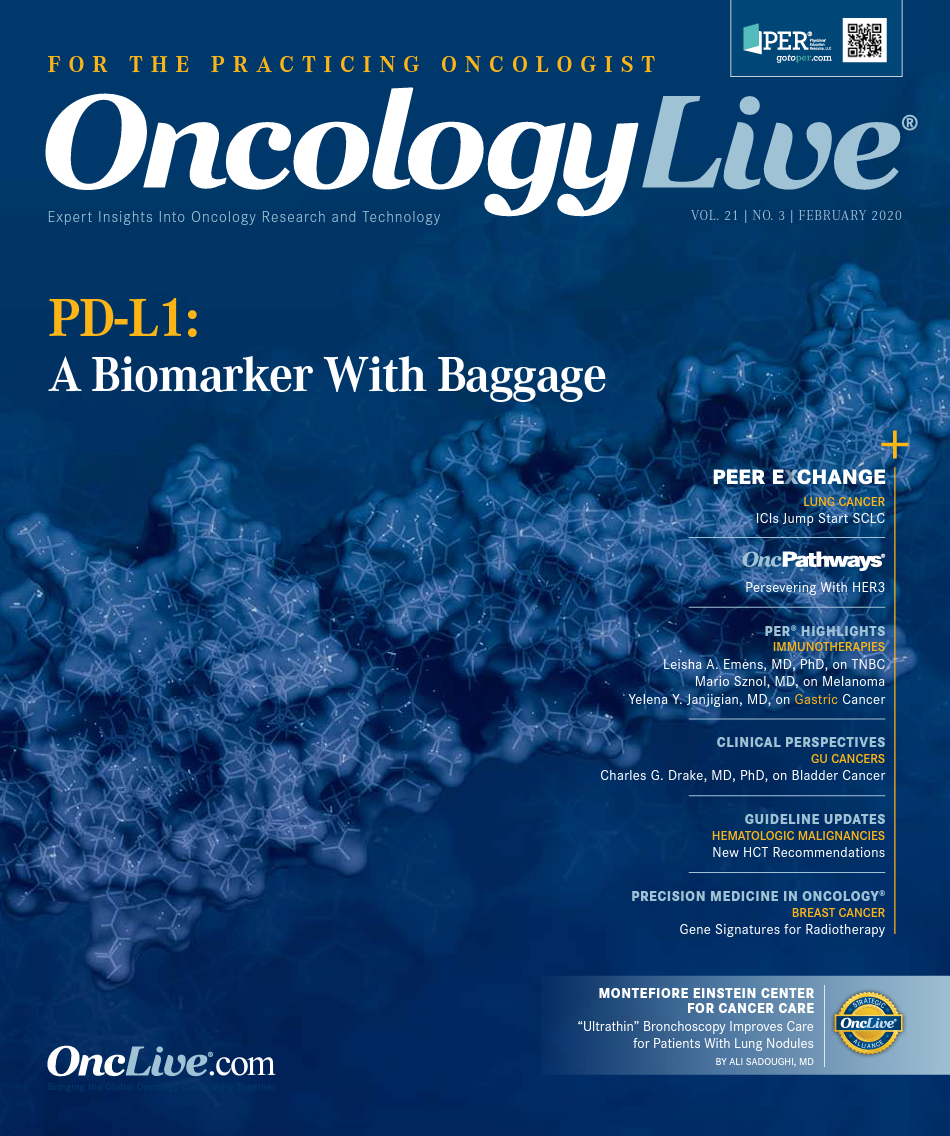Patients With HER2+ Breast Cancer Gain Potent Option in Third-Line Setting
Fam-trastuzumab deruxtecan- nxki received a green light from the FDA in December 2019 after updated data demonstrating a confirmed objective response rate of 60.9% were presented at the 2019 San Antonio Breast Cancer Symposium.
Shanu Modi, MD, medical oncologist at Memorial Sloan Kettering Cancer Center

Shanu Modi, MD
A new drug is giving hope to patients with HER2-positive breast cancer who have failed multiple lines of therapy. Fam-trastuzumab deruxtecan- nxki (Enhertu) received a green light from the FDA in December 2019 after updated data demonstrating a confirmed objective response rate of 60.9% were presented at the 2019 San Antonio Breast Cancer Symposium (2019 SABCS). The antibody-drug conjugate is approved in the third-line setting for patients with metastatic HER2-positive breast cancer.
“We put up the waterfall plot at the meeting, and it really does take your breath away,” Shanu Modi, MD, said in an interview with OncologyLive®. “You can see that almost every patient, even if they do not achieve a confirmed response, [gets] some benefit from this therapy. There are very few patients who don’t have benefit outright.”
Modi, lead investigator on the pivotal DESTINY-Breast01 (NCT03248492) trial and a medical oncologist at Memorial Sloan Kettering Cancer Center in New York, New York, spoke about trastuzumab deruxtecan’s efficacy and potential impact on the treatment landscape.
Could you please provide an overview of the patient population?
The population for phase II of this study [DESTINY-Breast01] was built on the success of the phase I study that preceded it. The patients were those who had HER2-positive metastatic breast cancer who had previously received treatment for their disease; specifically, patients had received treatment with T-DM1 [ado-trastuzumab emtansine; Kadcyla], which is one of the most active therapies for HER2-positive breast cancer.
Ultimately, we ended up enrolling patients who actually had a median of 6 lines of prior therapy. They had a number of treatments, and all patients did in fact, receive prior trastuzumab [Herceptin] and T-DM1, as it was an eligibility requirement, and about two-thirds also received pertuzumab [Perjeta]. These are what we would consider the most potent HER2- targeted therapies available today, and this study represents a modern cohort of patients treated with the best therapies for HER2-positive breast cancer who still have a need for more therapy.
Also, about half the patients on the trial were hormone receptor positive as well as HER2 positive, which is within range of what we typically see with HER2-positive disease. Ninety percent had visceral metastases— again, something we expect with HER2-positive breast cancer. And 13% had brain metastases. These are, of course, patients who had treated and stable brain metastases when they enrolled on the trial.
We enrolled patients from 3 continents on this study.
Can you discuss the efficacy data that led to the approval?
The primary end point of the safety trial [DESTINY-Breast01] was objective response rate as determined by independent review. In the trial of these heavily pretreated patients, we saw an overall confirmed response rate of 60%; this is consistent with results from the phase I study. It is always reassuring to have validation and consistency of data. Overall, the disease control rate was 97%, which means that almost every patient we treated with trastuzumab deruxtecan had some benefit.
As important in some respects is the durability of the response. There is a median duration of response of 15 months, so patients stay on this therapy for a really long time. The overall median progression-free survival on the trial was 16 months.
To put this into perspective, using the currently available therapies for refractory patients who are in the third-line setting and beyond, we would expect to see response rates of 10% to 30% and a median progression-free survival of 3 to 6 months. So the data for trastuzumab deruxtecan are striking. I think this is an extremely active treatment, and the phase II data are impressive in terms of the anticancer activity.
Can you describe the mechanism of action?
Trastuzumab deruxtecan is an antibody-drug conjugate; these are unique drugs designed to provide targeted delivery of very potent anticancer therapy. Trastuzumab deruxtecan is comprised of a HER2- targeting monoclonal antibody, essentially trastuzumab, and attached to this via cleavable linkers is a cytotoxic, also called the payload. In this case, that payload is deruxtecan, which is a topoisomerase I inhibitor.
We don’t routinely use this type of chemotherapy agent in the treatment of patients with breast cancer, so not only is trastuzumab deruxtecan a very potent therapy, but it’s also very novel. If we compare trastuzumab deruxtecan with T-DM1, which is the other available HER2-targeting antibody-drug conjugate, we see some notable differences. The payload for T-DM1 is a tubulin-targeting type of chemotherapy that patients with breast cancer are often already exposed to in other lines of therapy, so it is not as novel. Additionally, there are twice as many chemotherapy molecules linked to each antibody with the trastuzumab deruxtecan—approximately 8— compared with 3 to 4 with T-DM1.
The chemotherapy in trastuzumab deruxtecan also has a very short halflife and is membrane permeable, unlike the chemotherapy in T-DM1, which cannot permeate cell membranes. This allows trastuzumab deruxtecan to be active against not only HER2-positive cells but also surrounding tumor cells that may not have HER2 expression, hence a broader range of activity.
What else do we know about the agent’s tolerability?
The most common adverse events that we saw on a day-to-day basis in the trial were gastrointestinal [GI] and hematologic which is what we might expect from a topoisomerase I inhibitor. The most common adverse event was nausea, which was managed successfully with antinausea medications. Overall GI adverse events were mild in nature and could be managed with supportive therapies. Bone marrow suppression leading to low blood cell counts were typically grade 1/2, and we were still able to deliver the therapy.
Lung toxicity is an important risk with trastuzumab deruxtecan that we first identified with this antibody-drug conjugate in the phase I study. We were vigilant for it in the phase II study. Overall, about 14% of patients in the phase II trial had some evidence of lung toxicity, and that ranged anywhere from asymptomatic findings on CT scans up to a few grade 5 fatal events from interstitial lung disease.
Potential lung toxicity is something that patients and physicians need to be made aware of because it requires careful monitoring of patient symptoms so that treatment can be interrupted, or sometimes even permanently discontinued, to prevent serious lung consequence. Education is going to be required when the drug is made available—educating the physicians who prescribe the drug as well as advising the patients to report any new or changing symptoms, particularly pulmonary-related symptoms, so that interventions can happen early and we can prevent serious toxicity.
On the other hand, we did not see concerning cardiac toxicity, which is a risk we do see with other HER2-targeting therapies.
How does trastuzumab deruxtecan fit into the current treatment paradigm?
Based on current guidelines for patients who have HER2-positive metastatic breast cancer, our preferred first-line therapy is a combination of a taxane chemotherapy plus trastuzumab and pertuzumab based on the survival data for this triplet therapy from the CLEOPATRA trial [NCT00567190]. In the second-line setting, we tend to use T-DM1 because it has proven to be superior to the other available options.
This leaves trastuzumab deruxtecan as a drug for the third-line setting and beyond.
What are the next steps for trastuzumab deruxtecan?
A number of phase III trials are already under way. First, the confirmatory phase III randomized trial for our DESTINY-Breast01 study, called DESTINYBreast02 [NCT03523585], has been open for over a year and is currently enrolling the same population of patients with HER2-positive metastatic breast cancer who have had prior T-DM1. Patients will be randomized to either trastuzumab deruxtecan or physician’s choice [of capecitabine plus either trastuzumab or lapatinib].
Second, DESTINY-Breast03 [NCT03529110], another randomized phase III trial, is examining trastuzumab deruxtecan in the second-line setting. These patients will be randomized to either T-DM1 or trastuzumab deruxtecan, so it is a direct comparison.
Finally, the randomized phase III trial, DESTINY-Breast04 [NCT03734029], is enrolling patients with HER2—low breast cancer. In this study, patients who have HER2 1–positive or 2–positive (FISH negative) expressing breast cancer will be randomized to either trastuzumab deruxtecan or physician’s choice of standard-of-care chemotherapy.
We know that trastuzumab deruxtecan is extremely potent, and in the early preclinical work, even HER2—low expressing cancers were susceptible to the effects of this antibody drug conjugate. The phase I trial of trastuzumab deruxtecan included a cohort of patients with HER2–low expressing breast cancers, and these patients also had a substantial response rate to trastuzumab deruxtecan. This is the first HER2 targeted therapy that seems to work in in cancer which we have traditionally called HER2 negative. It’s very exciting to think we might be able to take advantage of targetinng HER2 for a whole new population of patients.
Trastuzumab deruxtecan is active not only in breast cancer, but also in HER2-expressing gastric cancers, and investigators are looking at it in colon cancer, in lung cancer, and in patients with other HER2-mutated cancers. It is active across a broad spectrum of tumor types, and studies are also looking at it in combination with other targeted therapies to maximize its potential.
At some point, we may be able to move this drug into an early stage setting, where the goal is to try to cure more patients and prevent recurrences.
Is there anything else you’d like to highlight about this drug?
In spite of the successes, there still remain areas of unmet need for patients with HER2-positive disease—specifically the treatment and prevention of brain metastases. This is an area where we need to study trastuzumab deruxtecan’s efficacy specifically, and I know that preclinical studies and clinical studies are either under planning or under way in this regard. This past year we also saw data for other promising HER2-targeting therapies that could also be options for our patients one day. This keeps me optimistic about the future.
Editor’s Note: This interview took place prior to the FDA approval of fam-trastuzumab deruxtecan-nxki for the treatment of adult patients with unresectable or metastatic HER2-positive breast cancer who have received ≥2 prior anti—HER2-based regimens in the metastatic setting.




